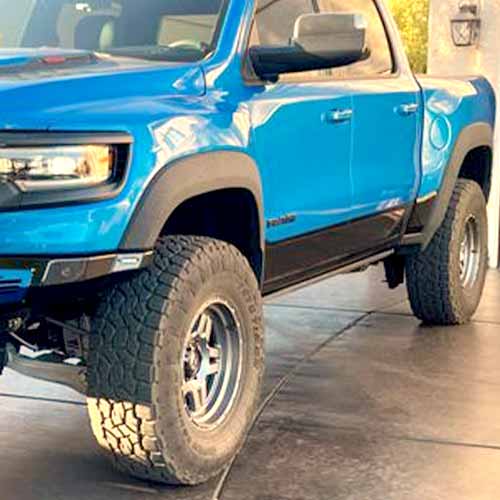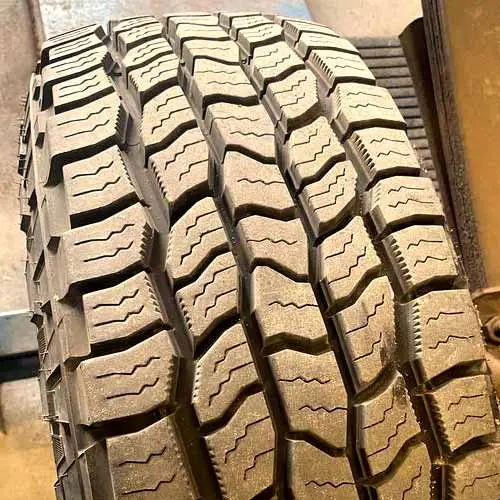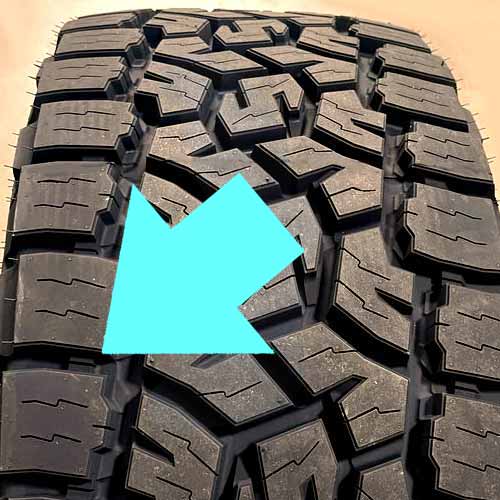Both the Toyo Open Country AT3 and the Cooper Discoverer AT3 are although from the same all terrain category, the Cooper AT3 is a more on road oriented tire in comparison, though it still provides you with sidewall lugs and staggered shoulder blocks along with snow vices which grants it 3PMSF rating like the Toyo AT3.

The Toyo Open Country AT3 provides a really nice dry grip and good highway stability, but the tire is not as responsive in comparison, as Cooper AT3 supply a better control over handling. And although there’s isn’t much difference in dry, on wet roads, it takes a noticeable lead by a large margin. Toyo AT3 on the other side, shows better rock climbing abilities, and traction over high speed gravel and dirt, but the tire is similar in durability.
Table of Contents
Durability:
Where all terrain tires need to be tough to handle rugged off road challenges, both of these tires surely are very weak.
Both of them have 2 ply casings of polyester, which carry 2 steel belts and just a single ply of nylon.
So both tires get to have 2 ply sidewalls, and with a single ply nylon reinforcement, a weaker overall structure.
This kind of construction is mostly seen in passenger tires, and although it’s still acceptable on Cooper AT3, it does not suit at all on the tougher looking design of Toyo AT3.
Tread Appearance:
Starting with Toyo Open Country AT3, it’s tread offers a very unique design.

All it’s S and F shaped blocks are closely packed together, and they have deep notches along with reinforced foundations, which aids in stability.
They are all also equipped with interlocking sipes which are full depth.
So it’s obvious from the image how these blocks are so much more aggressive than its shoulder blocks, where there aren’t any, except for siping, that’s same.
These blocks also don’t have lateral grooves in between as that area is covered with ridges which connect these shoulder together.
But they still make staggered shoulder blocks with traction scoops on the outer edges, as well as sidewall lugs (though still not as biting as the Cooper AT3).
But in comparison, the tire sure makes wider circumferential channels.
On the other side, the Cooper AT3 is although not as aggressive in looks, is still a bigger brother of it’s Discoverer family, which consists of 2 more, besides it, LT and 4S.

All these tires just hold minor differences where the Cooper XLT provides you with higher load ratings, and bigger tread voids, along with thicker sidewalls.
These sidewalls are also slightly thicker than Toyo AT3, so when pressured down, these provide good enough off road traction.
The tire also presents serrated shoulder blocks with slighter bigger traction scoops.
So overall, its safe to say that this tire provides you with aggressive sidewalls, while it’s competitor makes more competitive middle section.
For Cooper AT3, in the center, the tread makes 3 columns separated by wider longitudinal channels compared to inner 2.
And all blocks here are joined together in pairs by foundations (which adds to handling and braking stability).
Moreover, all blocks have full depth interlocking siping, which earns it 3 peak mountain snowflake rating just like the Toyo AT3.
Total sizes:
The Toyo Open Country AT3 offers more sizes, 148, ranging from 15 to 22 inches.
These sizes get to have speed ratings in Q,R,S,T and some even have H, whereas the load ratings go up to F, where weight changes from 28 lbs to 72 pounds.
If I talk about tread depth, it ranges from 12.7 to 17/32″, almost similar to it’s competitor.
On the other hand, the Cooper AT3 comes in just 32 total sizes, ranging from 15 to 20 inches.
Speed rating is either available in R or S, and load ranges, C to F.
Weight range goes form 44 to 70 lbs only (very similar trend is seen here). And tread depth is seen to be either 16.5 or 17/32″ in all sizes.
Learn all about speed rating: https://tiredriver.com/speed-rating-on-tires/
Which tire offers better value to money?
Price changes frequently, but both of these tires are still able to provide you with a good value for your money.
For Your Info: In my detailed list of all terrain tires (best ever), I’ve added Kenda Klever AT2 to be the best value for money tire. It’s probably the cheapest you can get with 3pmsf rating.
Tread Wear:
Tread wear is really influenced by the tire’s composition and construction. The more the weight and softer the rubber, the more the rolling resistance and hence wear.
Softer rubber basically don’t want to leave the surface off easily, while the larger weight accounts for more pressure on the ground. So it makes sense why both of these tires show such a good tread life.
Both tires have reinforced foundations underneath the ribs, which also includes shoulders (where connectors are placed in between them).
But still if I really have to pick one for tread life, I’d go with Toyo AT3, as the tire has a slightly rigid rubber composition, and it’s available in larger number of sizes, where lighter ones would do some much better here.
For Your Info: Toyo AT3 comes with 65k miles warranty, whereas the Cooper AT3 (XLT) comes with 60k.
On Road Performance:
Although both of these tires are marketed as all terrains, they are not too aggressive, to compromise their on road performance, and this especially goes for the Cooper AT3.
Let’s see how they performed on wet and dry.
Dry Traction:
Toyo AT3 offers vigilant response on even minor steering inputs, and its very surprising. It basically does this because of it’s stable shoulder blocks which are tightly packed with ridges in between, which enhances the overall tread steadiness, even during extreme cornering.
On curves, the sides of a tire, are largely operational (as they make the most contact), so the Toyo Open Country AT3’s highly firm shoulders provide greater functionality.
There aren’t any kind of notches or tread features in this area as well, so this further increases the contact with the road.
The Cooper AT3 on the other side, although provides a supple composition which sticks (and improves grip that way), the shoulder ribs of the tire don’t offer as much stability.
So handling is slightly compromised, comparatively.
Wet Traction:
Wet traction is conditional on sipes and again tire’s make up. And here its no surprise, that Cooper AT3 XLT is better overall.
This tire produces a very soft rubber, which gives it’s tread the needed stretchability, so the sipes get to squeeze and expand easily, wiping water away effectively.
It’s sipes are also wave like throughout the tread and with this 3D interlocking structure, the sipes don’t get rigid even under heavy pressure (during handling).
The Toyo AT3 on the other side, although have interlocking sipes as well, they are not a lot in number, and with overall stiffer composition, they also don’t’ get the required elasticity.
Noise:
Tread noise is based on the amount of air flowing in the tread, and most of that air goes out and comes in through the sides.
Now Toyo AT3 with ridges in there, creates a barrier for this air, so not a lot of it is able to get in.

Let me point it out so you can see, what I am talking about exactly.
These stoppers have a very small gap in between and so only a little bit of air gets in, and makes the tire silent overall.
The Cooper AT3 also uses this same feature. In fact, they were the first ones to come up with it, and they called it Whisper Groove Technology.
And if we compare both tires, the Cooper AT3 still provides better effectiveness here.
Besides connectors in between shoulder ribs, this tire has less wider rib gaps overall.
So less area is available for air to hit on rib walls.
And with 4 straight longitudinal grooves, it gives a more on road oriented design which is better at dampening the noise levels.
Comfort:
Noise is also a part of comfort, but it does not take up as much of it, as most of the ride comfort is based on the tire’s ability to dampen the bumps on the road.
The Cooper AT3 destroys the myth that AT tires aren’t able to provide good enough highway ride comfort.
The tire’s tread is very smooth which is able to absorb all kinds of impacts nicely.
On the other side, with stiff rubber composition, the Toyo Open Country AT3 is not able to provide as much efficiency.
Off Road Performance:
Off road, there are many number of terrain scenarios to consider, but with limited time on hand, I have discussed the most famous ones below.
Let’s check them all out one by one.
Rocky Terrain:
Sadly on rocks, where durability is highly needed, both these tires get to be very weak, so it’s not recommended that you go on tougher terrains without backup.
As both tires just have 2 ply sides without any polyamide/nylon reinforcement, they are going to get punctured very easily.
Cooper AT3’s weaker design is still understandable but the Toyo Open Country AT3, with aggressive outer design which supply a superior traction on rocks, is very odd. The tire provides a good lateral and longitudinal gripping on rocks while climbing, but it would not give you the confidence, that you may get with a tougher tire.
Speaking of which the toughest tire out there in the All terrain category is BF Goodrich KO2 (review).
Muddy Terrain:
Let me start off with mud, as it’s the most challenging terrain out there. And let me tell you, don’t expect too much out of these tires, yes, both of them.
They don’t do so good here and get stuffed with mud easily.
But still if you have to pick one, go with Toyo AT3, as at least this tire has interconnected grooves (designed in a better way).
Mud actually requires tread to self clean themselves, and Cooper AT3, although has circumferential grooves, they are not connected to each other properly, so mud can’t travel sideways on this tire.
Sand Performance:
On sand, you need a tire which is light, can go with lower pressure, (so stronger rim lock), and have thicker lugs (which provide paddling).
Now the good thing is both tires are very light and provide ample footprint.
But here the Cooper AT3 sides are better designed to give it larger amounts of traction on this soft terrain.
It’s sidewall lugs are chunkier and have concave shaped engraving on the sides (which make staggered shoulders ) and these are more precise and take up larger real estate on the sides.
So when pressured down, the tire provides a slightly larger tread print which awards it with larger grip on sand as a result.
Snow Performance:
Lastly if we talk snow, it’s so surprising to see that the Toyo Open Country AT3 despite not having enough siping gets to have 3 peak mountain snowflake rating (like the Cooper AT3).
It also is composed of a stiffer composition, but with Kevlar polymers in it’s make up, it’s still able to endure the freezing temperatures of the snow.
The tire actually provides a very unique design which is able to trap in the snow particles efficiently.
The S and the C shaped ribs hang on to the snow and supply abundant snow to snow contact (which is significant on this terrain).
The Cooper AT3 XLT on the other side, is also a great tire for snow, but it lacks just a tiny bit, as longitudinal grooves don’t do anything for the snow, though it still has snow vices (on outer longitudinal grooves).
Moreover, with a more flexible tread and stretching 3D siping, the tire is still not going to disappoint at all.
Take Home Points:
Both tires are 3PMSF and M+S rated, so like seen above, they are both great on snow.
On highways, the Toyo Open Country AT3 is superior on dry roads as it’s tread provides greater stability values.
Whereas the Cooper AT3 XLT is better on wet roads because of it’s effective siping design.
Both tires are great in hydroplaning. And off road, although they are not tough enough, the Toyo AT3 allows finer effectiveness.